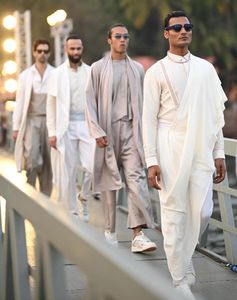I have just returned from what was a truly enjoyable weekend in Goa. On work. Attending fashion shows for a new idea called the India Men’s Weekend put together by the Fashion Design Council of India (FDCI).
The two-day showcase had a mix of designers—both established and new—putting together a mostly men’s-only showcase of some incredible styles. It took place on the jetty of the historic Aguada Port and Jail Complex, on literally a floating pier, so imagine the thrill of watching a fashion show while in the middle of the sea and the sky. The historic former jail, now a hip hangout with exhibition halls, cafes and bars, is among the sunshine state’s more popular events spaces.
Some of the designers who took part were the revered Rajesh Pratap Singh (his models actually emerged from the sea, their chic cropped pants and linen shirts drenched), Ashish Soni (who showed a variety of tailored options in monochromes), Antar-Agni (the label that made the men’s dhoti au courant again), Rahul Khanna and Rohit Gandhi, JJ Valaya, Shantnu & Nikhil (gorgeous tie-dye denim jackets), Krishna Mehta, Manoviraj Khosla, Siddharth Tytler, Dhruv Vaish (returned from a gig in Italy and focused on sharp tailoring), Vivek Karunakaran (loved the mundu with the jacket), Bloni, Khanijo, Countrymade, Pawan Sachdeva, Paresh Lamba and Kommal and Ratul Sood.
The event was small and attended by just a couple of hundred people. Yet, this is an event whose time has come. Menswear has begun to enjoy as much attention as womenswear in India. If one were to remove bridal lehengas out of the picture, Indian menswear enjoys just as much fanfare as designer women’s wear does. Perhaps even more, this bunch in Goa would argue.
Indian men have historically been peacocks. Most of our rulers enjoyed a gorgeous wardrobe, draped billowing fine cottons in their dhotis or angrakhas and showed off their wealth through their personal jewellery. It is only the British and their stiff upper lip that put a lid on men having fun with fashion.
But the peacock is dancing again. The last decade or more has seen men experiment with fabulous, eccentric, or unusual styles. Much of it was led by the US legalising homosexual marriages. Gucci’s new creative director at the time, Alessandro Michele, celebrated with a gorgeous new aesthetic: the man’s wardrobe borrowing heavily from the woman’s. Vivid florals, bright colours, and soft suits became the new language of menswear. The men became boys, pretty boys or girlie guys, and a new wave of soft masculinity arrived. Perhaps never to return.
This season we see Anthony Vaccarello inject women’s wear dress codes into menswear at Yves Saint Laurent (much like YSL himself had done 50 years ago with his ‘Le Smoking’ suit, inspiring women’s wear from menswear). Chiffon blouses, pussybows, floor-sweeping coats and high heels for men (GQ’s style editor Selman Fazil wore a pair of high-heeled boots on Goa’s pier too).
The Indian menswear market has been the fastest growing segment in apparels. It is valued at $30 billion as of 2023, and expected to reach $34.50 billion by 2027. But apart from the traditional players like Arvind Mills’ brands (USPA, Arrow, Flying Machine), and Aditya Birla’s (Louis Philippe, Allen Solly and Van Heusen), newer players such as Bombay Shirt Company, Rare Rabbit, Nicobar, Korra and Kaapus are bringing men a more stylish wardrobe.
FDCI chairman Sunil Sethi agrees. He says his event is aimed at highlighting the exponential growth of menswear fashion “illustrating the evolution from conventional attire to a refreshing representation of style”.
Look no further than Ranveer Singh, Karan Johar and Vijay Varma for cues.


